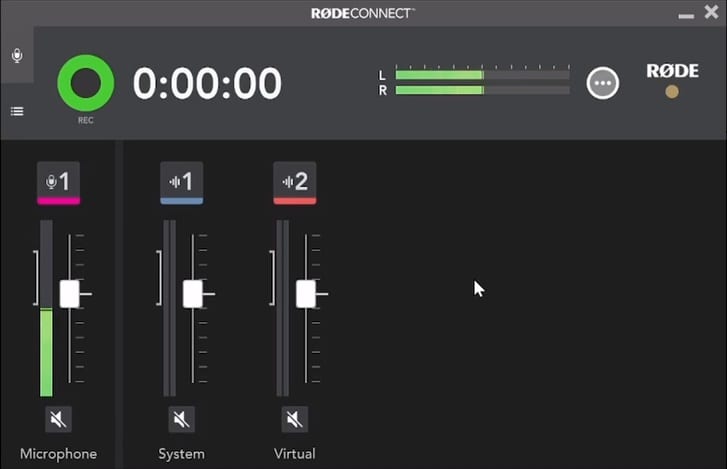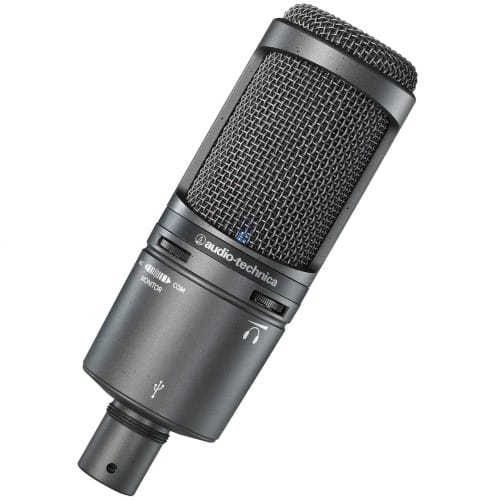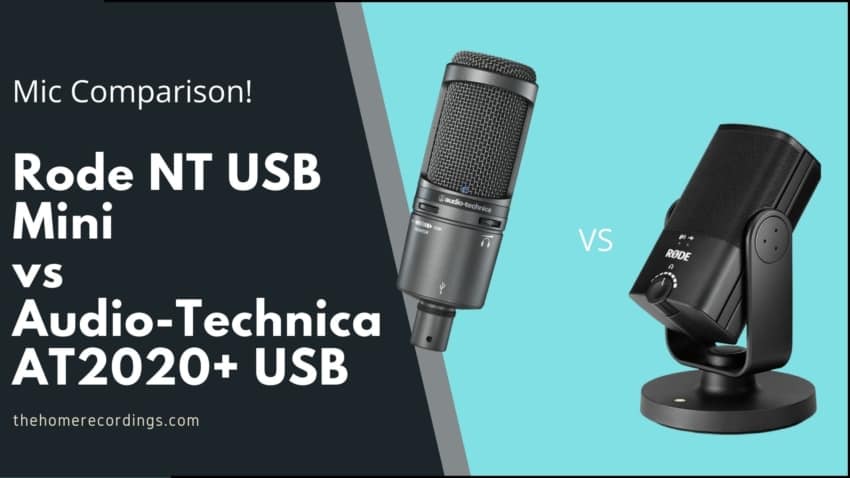Last updated on December 29th, 2023 at 09:53 pm
Rode and Audio-Technica have been bumping heads for years now, especially the AT2020+ USB with the Rode NT USB, but Rode recently released the NT USB Mini, which begs the question: Which one is best?
In this article, I will be going over the difference between these mics in terms of sound quality, build quality, price, and more, and I will be telling you which one I consider to be the better alternative.
So, without any further ado, let’s get started!
In short, here are the differences between the Rode NT USB Mini and the Audio-Technica AT2020+ USB: Both are condenser microphones and sound very similar, however the AT2020+ USB comes with gain, mix, and headphone knobs, whereas the Rode NT USB Mini only features a headphone volume knob, but it does come with the Rode Connect app which allows you to process the signal from a computer.
So, let’s get this show on the road, shall we?
Rode NT-USB Mini Overview

The Rode NT USB Mini is the little brother of the Rode NT USB, and it comes with the same feature set but at a much lower price tag. However, I don’t think that it sounds as full, but more on this in a second.
As far as the build quality goes, everything but the grille is excellent, since the grille does flex a little more than the one on the Rode NT USB (the big one), but it’s definitely not enough for me to worry about it getting damaged.
It features one knob on the front that lets you control the headphone volume and that also allows you to enable zero-latency monitoring when tapping on it. A light on top of the knob will turn on indicating that zero-latency monitoring is enabled (the second light only tells you if the mic is connected and getting power).
It comes with a 360-degree swing mount that is great for setting up the mic on a boom arm since you can turn it however you want until you get it just right.
Contrary to its bigger brother, the NT USB Mini doesn’t come with an included pop filter, but rather has one already built-in, although I have to say that plosives are still kind of an issue and I would recommend using an external pop filter just in case.
Now, you may have noticed that it only has one knob, which is the one that controls the headphone volume, but where are the gain and Mix knobs? Well, there are none, which is a shame, and you need to control both of these functions from your PC.
I thought Rode would’ve learned after not including a gain dial on the NT USB, but they actually went further and removed one more knobs.
It’s worth mentioning, however, that even though it would be nice to have dedicated knobs to control the gain and the mix between the computer’s playback and the direct signal, all of this can easily be adjusted through their Rode Connect software.

The Rode Connect software lets you use up to 4 Rode NT USB Minis one a single computer, access some processing which are built into the mic, such as a gate, compression, and more, and it also lets you control the playback volume of different apps and games, which lets you create a nice mix for your stream (great software for gamers).
Lastly, it doesn’t come with a shock mount, and when using it with the included desk stand, it will absolutely pick up all the keyboard strokes, tapping on the desk, or any other types of vibrations that may be present. So, for all you gamers out there, get a boom arm!
What comes in the Box?
- Rode NT USB Mini Microphone
- Desktop Stand
- Microphone Stand adapter
- UNB Cable
Features
- Comes with the Rode Connect Software (Great for streamers & gamers)
- Built-in pop filter.
How does it sound?
The Rode NT USB Mini offers a very balanced sound, especially when recording voice-related stuff and singing: The low end isn’t too prominent or boomy while still being extremely present, the mids are actually quite prominent but I like how this affects the vocals, and the high end is very open and airy without sounding shrill.
So, at least as far as vocals goes, it’s a very balanced sound, and I though the same when recording my acoustic guitar since there was nothing really standing out to me as overly harsh.
The one con I can think of is that, since the mid frequencies are a bit more prominent than in other mics, people who have a very nasally voice might find that that nasally sound will be slightly exaggerated.
Lastly, when recording my electric guitar, it sounded great when recording a clean signal, but I didn’t really like recording distorted guitars with it since it made them sound quite shrill.
And lastly, the headphone amp that the Mini comes with is great: It has enough power to drive the Sennheiser HD 650!
Specifications
- Polar Pattern; Cardioid
- Frequency Response: 20Hz- 20kHz
- Sample Rate: 48kHz/24-bit
- Max SPL: 121dB
- Weight: 585g
Get the Rode NT USB MINI here.
- Rode NT USB MINI: Amazon, Sweetwater, Guitar Center.
Audio-Technica AT2020+ USB

There are few better-known brands in the music industry than Audio-Technica. They make some of the best microphones available on the market and the AT2020 is the go-to mic for almost every beginner home recording enthusiast, plus you won’t see a studio that doesn’t have at least a couple of them.
The USB version of the Audio-Technica AT2020 is just as good as the XLR AT2020 with the advantage of being a plug n’ play microphone that works both on Windows and Mac OS without the need of installing any sort of driver.
It comes with a built-in headphone jack and a volume control that allows you to directly monitor what is being recorded with no delay (Zero latency). It also offers a mix control that blends the microphone and the pre-recorded audio.
The controls on the AT2020 aren’t as easy to use as I would have liked, but at least it has more controls than the Rode NT USB Mini (I really like being able to adjust the gain directly from the mic, having to do this via software isn’t really my thing).
As far as build quality goes, the AT2020+ is extremely well built: When holding it in my hand it doesn’t feel like a cheap product at all, quite the opposite in fact. I have to give props to Audio-Technica here since I’ve never tried a mic of theirs that doesn’t feel extremely solid).
Lastly, the AT2020+ can be used for anything voice related, recording music, YouTube videos, etc.
How does it Perform?
Since the AT2020 is a plug n’ play microphone, you should have absolutely no issues getting it to work; simply connect it and that’s it, you can now record! However, the same goes for the Rode, so no points for the AT2020 here.
The sound quality is excellent, and I mean excellent, especially considering the price, since you probably won’t find another USB microphone at this price range that sounds this good (maybe the Elgato Wave 3, but that one is made of plastic).
The only thing I don’t like that much is that it can sound a bit crispy at times, but that isn’t that much of an issue really since you can fix that with just a bit of EQ afterwards.
I often refer to the AT2020+ as my top recommendation for anyone who is looking for a cardioid condenser USB microphone simply because of the overall sound quality and price.
It records vocals extremely well and I believe that recording voice-related audio is where this microphone really shines.
Of course, it can be used for recording acoustic and classical guitars as well, which is what I used it for before getting some of the other microphones I own.
One big con though is that when recording an overdriven electric guitar it may take you a while to fine-tune the tone and to find the correct mic position, and this is an issue that I had since it took me over 10 min to get a decent tone out of it, and I still didn’t quite like it.
Everything else sounded fantastic!
There’s a reason why the AT2020 (XLR Version) is part of almost every music studio, and that is because when taking cost-effectiveness into account, there are few microphones that can stand up to it.
The USB version is just as good, a bit more expensive, but it doesn’t require you to purchase a separate audio interface!
Related: Here’s a post where I compare the Blue Yeti to the AT2020+, should you be interested.
What do you get in the Box?
- The Audio-Technica AT2020+ USB microphone
- Tripod desk stand
- USB cable
- Storage Pouch
Features
- Headphone Output with volume control
- Tripod desk stand and USB cable included
- Mac and PC Compatible
- Built-in headphone jack
- Mix and Volume Control
Specifications
- Polar Pattern: Cardioid
- Frequency Response: 20Hz- 20kHz
- Sample Rate: 44.1kHz – 48kHz/16-bit
- Weight: 386g
Get the AT2020 USB here: Amazon, Sweetwater, Guitar Center.
Which one should you go for?
Both of these microphones are actually great, and although I generally recommend the AT2020 USB over other USB mics, this time I’m glad to say that it’s a bit different because of the price difference, since the NT USB Mini is just so much more affordable while still sounding almost as good (the sound quality is practically identical and I don’t think one could be considered better than the other, they sound slightly different so some people may like one more than the other depending on their voice or the instrument they are recording).
In addition to the lower price and smaller size, the NT USB Mini also comes with the Rode Connect software, which is something that the AT2020 USB lacks, and this makes it an even better alternative for streamers and gamers, not so much for musicians though.
You can’t go wrong with both, but the Rode NT USB Mini offers a better value overall, at least in my opinion. If I had to choose, I’d go with the Rode.
Other alternatives
I reviewed a couple USB mics already and there are two that stand out: The ElGato Wave 3 and the Samson G-Track Pro.
The Elgato Wave 3 is a relatively new mic that was designed specifically for gamers since, similar to the Rode NT USB Mini in some sense: It comes with included software designed to help you better control the signal (compression, limiter, it lets you manage and mix the level of different audio signals, such as music playing, the stream’s volume, mic volume, etc.).
The Samson G-Track Pro is an interesting alternative, mainly for guitarists and bassists since it features an instrument jack that lets you record both the microphone signal and the instrument signal to separate tracks, and you can even use it with amp simulation software with very low latency.
FAQs
Are Rode mics better than Audio-Technica? Both Rode and Audio-Technica microphones are of similar quality, both in terms of sound and build quality, and they also tend to sell for in a similar price range. So, one is not better than the other, they are very similar.
Is Rode NT-USB mini good for vocals? The Rode NT USB Mini’s strong point are vocals since it’s got a very prominent mid range with a nice and open airiness to it. The only problem with this boosted mid range is that nasally-sounding voices will sound even more nasally.
Is Rode NT mini good? The Rode NT USB Mini is probably the best USB microphone under $100 because of how balanced it sounds and how well it’s built, plus it comes with the Rode Connect app which allows you to control the signal even further.
